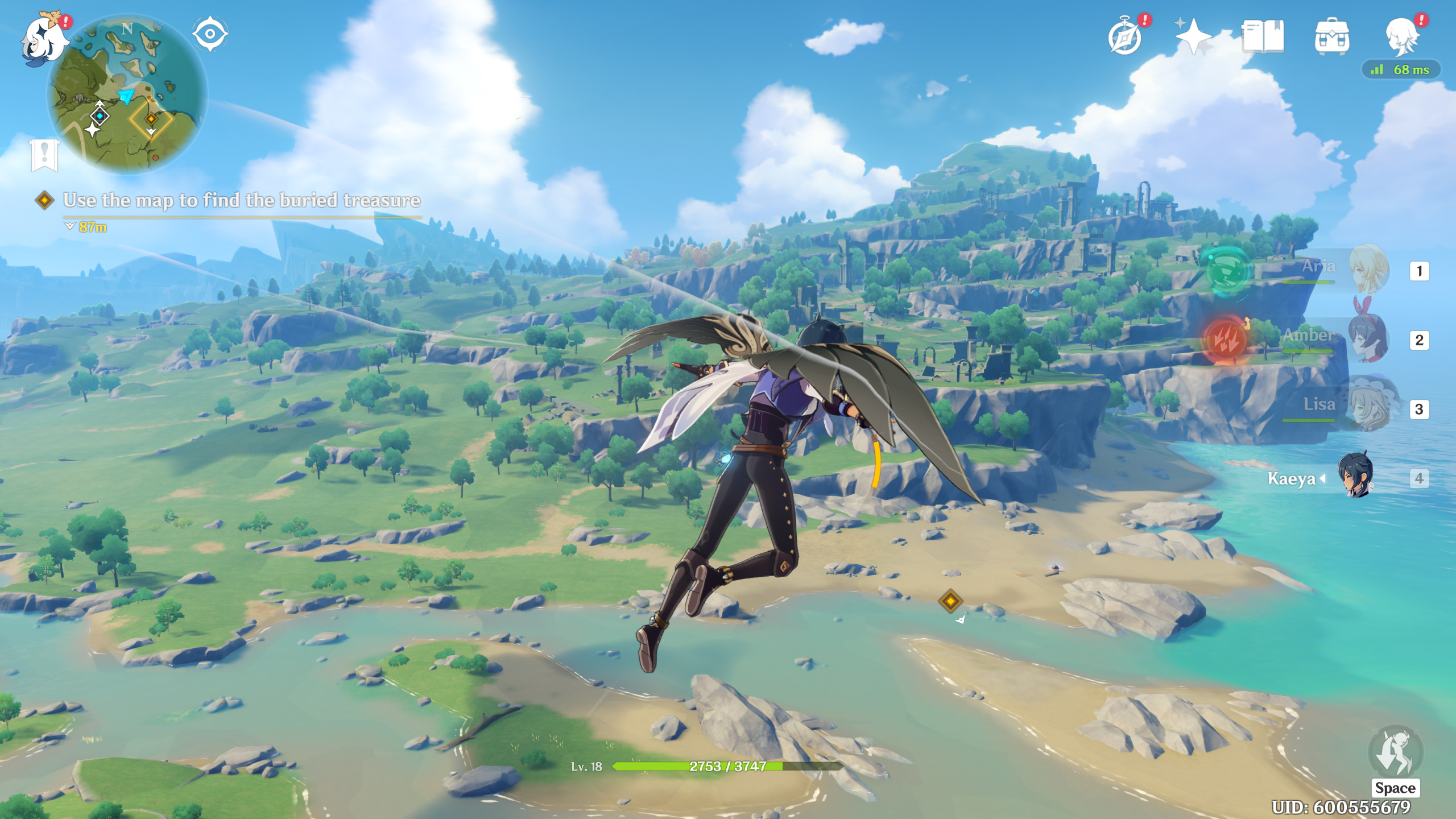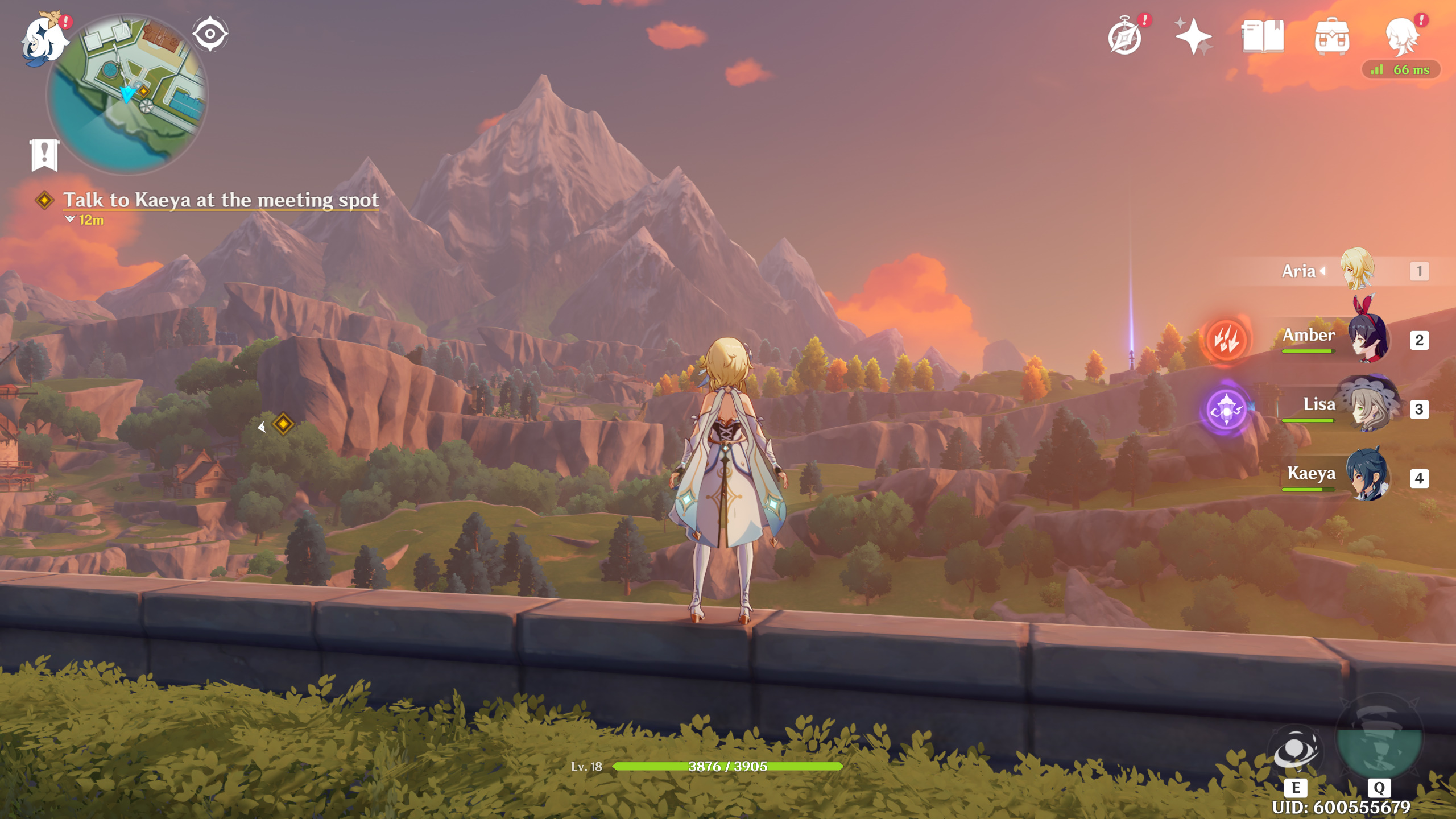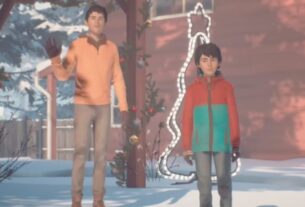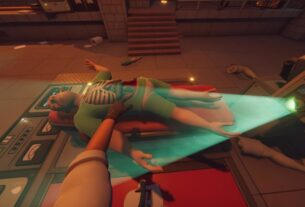
I shouldn’t like Genshin Impact as much as I do. It has lootboxes with dreadfully low drop rates, an energy system that limits how quickly I progress at higher levels, and an extremely annoying sidekick that refers to itself exclusively in third person. These flaws would doom other games, but Genshin Impact is also a fantastic RPG set in a vibrant open world that is so much more fun to explore than most full-priced games I’ve played this year.
What is it? A free-to-play RPG inspired by Breath of the Wild
Expect to pay: free with microtransactions
Developer: MiHoYo
Publisher: MiHoYo
Reviewed on: i7 7700, RTX 2070, 16GB RAM
Multiplayer? 4-player co-op
Link: https://genshin.mihoyo.com/
If Genshin Impact has a secret weapon, it’s that it isn’t afraid to swipe features from other games, most notably The Legend of Zelda: Breath of the Wild. Just like Nintendo’s seminal hit, there’s an enormous world to explore that’s teeming with secrets, puzzles, and cleverly hidden loot. There are mercifully few icons on the map, so a lot of the exploration is self-guided. I have to climb mountains, glide across canyons, and pay attention to my surroundings if I hope to discover it all. It might offend hardcore Nintendo fans, but Genshin Impact doesn’t just thoughtlessly copy and paste these ideas. It expands on and tweaks them to fit really nicely into a loot-obsessed RPG that is—despite what its roots in mobile games might imply—incredibly fun to play.
Whole new world
It’s actually easier to understand Genshin Impact if you think of it less like a free-to-play mobile game (that’s also on PC and PS4) and more like a proper singleplayer JRPG like Ni No Kuni 2 or Tales of Vesperia. You play as one of two interloping twins whose dimension-spanning vacation gets ruined by a mysterious god. Whichever twin you choose to play as is dropped into the medieval kingdom of Teyvat and embarks on a quest to find their sibling. It’s a journey that leads you from being inducted into an order of knights to proving your innocence after being accused of murdering a local demigod. Sure, Genshin Impact might be a Chinese game, but it walks and talks like a JRPG.
It’s cliche and not exactly riveting, but the story is still a lot of fun. My sidekick, Paimon, annoys the hell out of me but the rest of the cast are a likeable bunch thanks to expressive and energetic English voice acting. Though some quests are forgettable filler, I really enjoy the ones that focus solely on particular characters in my party. In Xianling’s quests, for example, I took on the role of her sous chef in a cooking competition, making difficult choices over what ingredients to include in dishes or having to ensure they’re properly cooked. It’s the kind of cute, lighthearted fun I find myself clinging to in the waking nightmare that is 2020.
Genshin Impact strikes a near-perfect balance between the intrinsic fun of exploring with extrinsic rewards like loot.
The story isn’t the reason Genshin Impact took over my life for a few weeks, though. It’s what happens when the game inevitably tells you to go level up for a bit before you can move onto the next chapter. In a game like Assassin’s Creed Odyssey, I resented how the story was gated by my level because it felt like my mom arbitrarily forcing me to go outside for an hour to get some exercise. In Genshin Impact, though, being told that you have to level up a bit before you can continue is a blessing because exploring is what Genshin Impact does best.
The two regions of Mondstadt and Liyue are not only enormous but absolutely packed with puzzles that encourage you to pay careful attention to your surroundings at all times. Hidden chests full of loot are tucked into most nooks, but you might see a trio of torches and decide to use some fire magic to light them and get a reward. Or you’ll find a wayward spirit that guides you to some hidden treasure, or find special collectibles that can be offered to special statues to increase your overall stamina.
Some of these puzzles only take seconds to solve while others are more involved—cryptic riddles or hidden switches that require clever use of your magical abilities. It’s a world so densely layered with treasure that at times I’ll look out at a vista and feel a little overwhelmed by all the things I can see and want to investigate. It’s not uncommon for a short trip from one destination to the next to turn into a spiralling detour as I stop to investigate a ruined village, then collect some nearby ingredients, open a treasure chest tucked into a crevice, only to then see some suspiciously-placed, unlit torches.
If I spend an hour wandering around and I’ll quickly rack up a ton of equipment that can be broken down for crafting or used, money and resources for upgrading your different party members, and the currency needed to buy lootboxes. I’ll also earn experience points toward my Adventure Rank, which is what unlocks more story quests along with features like special dungeons, daily quests, and even a co-op mode so I can explore with three friends—though it’s restricted to only a handful of activities that significantly limits its potential.

It’s a collection of systems I like a lot more than most open world games because it strikes a near-perfect balance between the intrinsic fun of exploring with extrinsic rewards like loot. In Breath of the Wild, for example, I might spend an hour wandering and only have a handful of useless gemstones to show for it.
I love how neatly combat folds into this fun loop of searching and looting. Though my party consists of four characters, only the one I’m actively controlling appears on screen at any given time. With the press of a number key, though, I can switch to one of the other three in a snap, immediately letting me start wailing on enemies or use their abilities to solve a tricky puzzle.
Each character belongs to one of six elements that empowers their abilities and can interact with the environment and enemies in surprising and delightful ways. If it’s raining, an ice character like Kaeya can freeze enemies solid with his special abilities, or I can use Lisa’s lightning attacks to make them superconductive so they constantly electrocute anyone nearby.
The environment reacts to all this magic, too, so I can freeze water to make an ice bridge or start a grass fire that’ll sweep into an enemy camp and detonate the powder kegs they have stored there. A lot of puzzles also require a certain type of magic, like using Amber’s fire arrows to light distant torches to reveal a hidden chest or using my main character’s earth ability to drop a heavy stone on a switch so a door will stay open.
Figuring out all of these interactions is great, but what’s really fun is building parties that can exploit each other’s elemental magics to create explosive combos that absolutely melt the HP bar of even the toughest enemies. Because enemies are often themselves elemental, it becomes a bit like Pokémon where I’m trying to exploit an elemental weakness while defending against my own. If I’m fighting a towering, gnoll-like Mitachurl and he has a shield, for example, I’ll switch to Xianling and toss her magic, fire-breathing panda into the fight so it can light the shield on fire. Then I’ll switch to the main main character and use her wind ability to turn those flames into a fiery vortex that obliterates the shield—and often its wielder—almost instantly. Of course, a lot of enemies will also try and use these tricks against you as well, so I always have to be aware of my own weaknesses too.
It’s a simple enough system that I mastered it in just a few hours, but it never gets boring. The unpredictability of the weather, environmental features like dry grass or explosive barrels, and my enemies’ own elemental abilities keep things feeling unpredictable and exciting.
Caveats galore
After playing for 40 hours, it’s almost baffling how little these lootboxes matter.
You can’t talk about how great Genshin Impact is without acknowledging its crappy monetization practices that go beyond what you’d normally see in free-to-play PC games. Some of it is pretty standard stuff, like a battle pass with an optional premium track that costs real money to unlock. But Genshin Impact also sells lootboxes called Fates that cost around $3 that go far beyond the usual cosmetic skins. Fates drop new characters for your party or powerful new weapons for them to use in battle. The rarest of these only have a 0.6 percent chance to drop—though there are some “pity” systems in place that guarantee a top-tier reward if you don’t get one after opening a whopping 90 of them.
If you’ve played any of the big mobile gacha games like Raid: Shadow Legends or Arknights, you’ll already be familiar with these systems, but this is the first time I’ve played a PC game that uses them. As the kids would say, it’s a little sus.
The good news is that, after playing for 40 hours, it’s almost baffling how little these lootboxes matter. You earn the currency needed to purchase them at a generous pace from various activities, and the characters and weapons you’ll find just by playing the main campaign are more than enough to see and enjoy most everything there is to do. In addition to the six characters I got for free from the story or through special in-game events, I’ve earned an additional eight and the only thing I bought was a $5 subscription fee-like item that gives me an extra chunk of premium currency each day.

Even if you don’t get as lucky as me, none of this will stop you from exploring all you want. The characters you are given for free are an eclectic bunch with a variety of different abilities that’ll be useful both in combat and out in the world. If you care about optimizing your team or min-maxing individual characters, however, Genshin Impact will absolutely rob you blind.
It’s a weird issue that I didn’t encounter until reaching level 40 and completing most of the story, but Genshin Impact’s endgame grind is pretty unbearable. Each character in my party and their weapons has an individual level that is increased by feeding it certain resources, but at certain thresholds, like level 20 and 40, you have to “ascend” by tracking down some rarer resources.
I actually love this idea and the first few times I ascended characters I enjoyed treasure hunting for the right materials, but the problem is that most of this stuff is awarded for killing certain bosses or doing special dungeons called Abyssal Domains. Both of these activities (and a few others) require you to spend a regenerating resource called Resin, but I only get so much each day and it’s shockingly easy to blitz through my stockpile.
This didn’t annoy me early on because I was still so wrapped up in exploring and completing the story, but now that I’ve completed most of that the only real goal left is to power up my characters and take on a few remaining ultra-difficult challenges. But the grind is so bad that I don’t even want to bother. It takes me all of 20 minutes to use up my Resin and then I have to wait a full 16 hours before I have more, and everything I need to grind requires it. I might spend all my daily Resin getting some upgrade materials for my sword only to not be able to ascend it because I don’t have enough money, but I can’t grind for that either because I just spent all my Resin.

Genshin Impact is so close to being a revolutionary free-to-play game that transcends this exploitive, manipulative bullshit.
It’s not just about each character’s overall level, either. Their individual abilities also need to be upgraded in a similar manner, and then there’s a skill tree called Constellations that I can only level up by getting lucky enough to get a duplicate of that character from a loot box. Considering the rarest characters only have a 0.6 percent chance of dropping, I’d probably need to spend tens of thousands of dollars or play for tens of thousands of hours just to fully upgrade my characters.
If you’ve played a gacha mobile game before, this won’t surprise you, but I find it especially frustrating because Genshin Impact is so close to being a revolutionary free-to-play game that transcends this exploitive, manipulative bullshit. It’s weird that it gives so much away for free—a sprawling, high-quality story and a beautiful open world that can take 40-plus hours to fully explore—only to then clamp down so hard on the endgame grind. I went from being able to play Genshin Impact for hours on end like a proper RPG to jumping in for 15 minutes each day before being arbitrarily forced to stop because I’ve run out of Resin. I could pay to restore it, but that feels like an enormous waste of money. I’d rather just play something else.
It’s such a jarring and abrupt change that really highlights how carelessly these monetization systems have been implemented. I desperately wish its developers would find a better way because I’d happily pay up and support its ongoing development, but I’m not going to gamble my money on lootboxes with odds this bad.
This doesn’t change the fact that Genshin Impact is one of my favorite games this year, it just sucks that we’ve been driven apart prematurely, especially when other free-to-play games manage to strike a much healthier balance in how they monetize. The way it stitches Breath of the Wild and classic JRPGs together is awesome, and the fact that you can enjoy so much of the game for free absolutely still makes it worth playing. Just understand that, at some point, you’ll smash into that wall. Maybe if you know it’s coming, it won’t hurt so much.
Read our review policy
Genshin Impact’s open world and clever combat are fantastic, but its endgame tries way too hard to milk you for cash.



